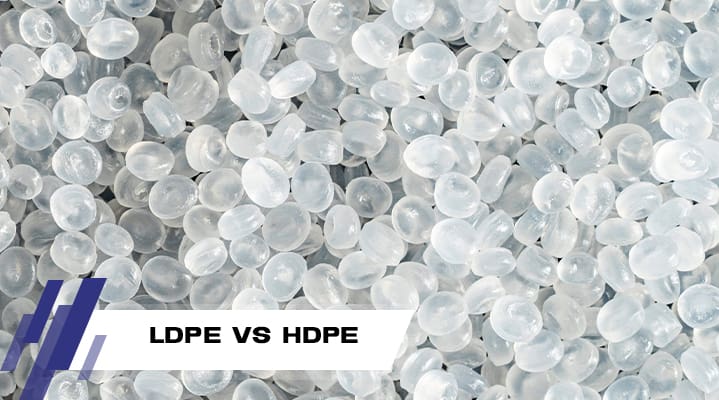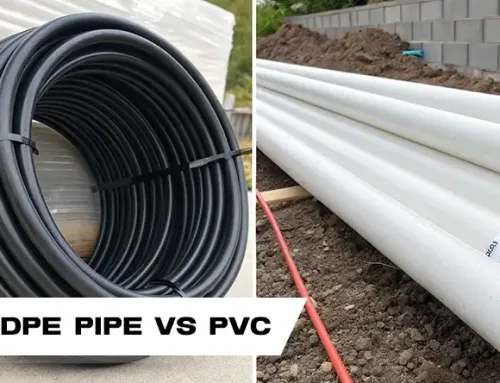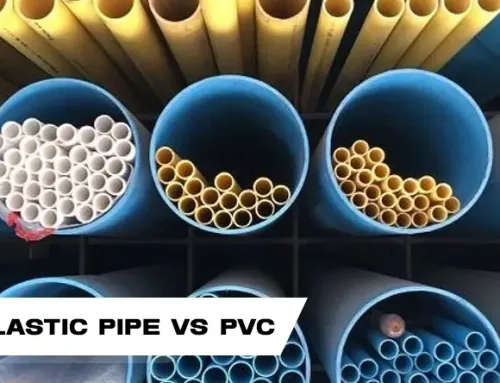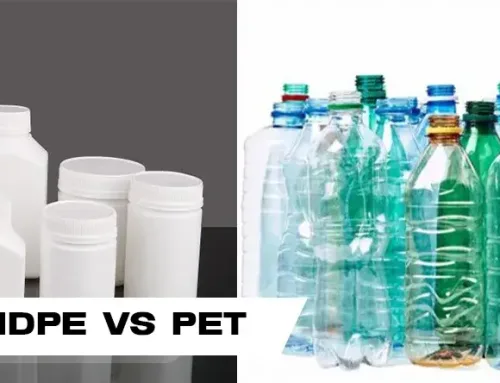Polyethylene (PE) is one of the most widely used thermoplastics globally, manifesting in various forms tailored for diverse applications. Among its most prominent and commonly compared styles are High-Density Polyethylene (HDPE) and Low-Density Polyethylene (LDPE). While both fall under the PE umbrella, their distinct molecular structures lead to significant variations in their properties and uses.
HDPE is highly appreciated for its stability, rigidity, and strength, making it appropriate for projects like piping and durable receptacles. Conversely, LDPE is renowned for its flexibility and pliability, widely used in products such as plastic bags. To thoroughly understand their unique characteristics, we need to delve into their molecular design and how these translate into real-world performance. Today, we will explore the difference between HDPE and LDPE structure, examine LDPE vs HDPE examples, discuss what topology LDPE and HDPE exhibit, and compare LDPE vs HDPE chemical resistance. Stay with us to gain a comprehensive understanding of these essential polyethylene types.
Understanding Low-Density Polyethylene (LDPE)
Let’s begin our exploration of HDPE vs LDPE by examining what LDPE is. Low-Density Polyethylene (LDPE) is a highly pliable and lightweight plastic material. The defining characteristic of LDPE is its highly branched molecular structure. This extensive branching (both long and short chains extending from the main polymer backbone) prevents the polymer chains from packing together tightly and forming highly ordered crystalline regions. This loose structural arrangement results in LDPE’s lower density and distinct mechanical properties. LDPE is highly prized for its exceptional flexibility, high impact resistance, and waterproof nature, making it ideal for applications requiring a soft, conformable material. Different grades of LDPE are available, each tailored for specific performance needs, but all share this fundamental branched structure.
Understanding High-Density Polyethylene (HDPE)
In the second part of our LDPE vs HDPE comparison, particularly relevant for items like HDPE vs LDPE bottles, we will delve into what HDPE is. HDPE or High-Density Polyethylene is a robust and strong plastic. The combination of its superior chemical and mechanical properties are the most important reasons for its widespread popularity!
This type of PE is renowned for its excellent mechanical and chemical properties. Some of the key characteristics of HDPE include: very high tensile strength, significant rigidity, and excellent impact resistance. HDPE is typically opaque and possesses good UV resistance (especially when stabilized), making it well-suited for outdoor applications where it can withstand environmental damage without easily degrading. This makes HDPE grades safe for numerous long-lasting products, ensuring their integrity and performance over time.
HDPE vs LDPE: A Detailed Comparison Table
To provide a clearer understanding of the difference between HDPE and LDPE, here’s a detailed comparison of their key properties:
This table provides a comprehensive overview of the ldpe hdpe difference, guiding material selection.
Molecular Structure and Density: The Primary Difference Between HDPE and LDPE Structure
The primary difference between HDPE and LDPE structure lies fundamentally in their molecular architecture. HDPE possesses a highly linear molecular structure with minimal branching, allowing its polymer chains to pack together very tightly and efficiently. This tight packing is what gives HDPE its higher density and superior physical properties like rigidity and strength.
On the other hand, LDPE has a highly branched structure, featuring both long and short side branches extending from the main polymer chain. This irregular and extensive branching prevents the polymer chains from packing closely, creating more space between them. This structural distinction directly answers the question: “Why do LDPE and HDPE differ in density?” The tightly packed molecular chains in HDPE result in its higher density and strength, while the more loosely packed, highly branched chains in LDPE contribute to its lower density, increased flexibility, and transparency. Understanding these molecular topologies is key to discerning the ldpe vs hdpe structure characteristics.
Mechanical Properties: LDPE vs HDPE Properties in Strength and Rigidity
When evaluating HDPE vs LDPE in terms of mechanical properties, HDPE’s mechanical possessions are distinctly superior to those of LDPE in many aspects. In this comparison, HDPE is clearly seen to have the upper hand over LDPE in tensile strength, stiffness, and overall stress resistance.
- HDPE is inherently stronger, possesses greater tensile force, and is significantly more rigid. These properties make it highly suitable for uses in HDPE pipes (for water, gas, and sewage), heavy-duty containers (like large drums or milk jugs), and structural components where high load-bearing capacity and rigidity are essential.
- Conversely, LDPE excels in applications where extreme flexibility, pliability, and high impact absorption without cracking are paramount. It offers good toughness and resilience but lacks the stiffness and tensile strength of HDPE.
These contrasts highlight the key polymer parameters such as tensile strength, density, and melting point that are often analyzed when choosing between LDPE and HDPE for specific mechanical requirements.
Transparency and Chemical Resistance: LDPE vs HDPE Chemical Resistance
When comparing LDPE vs HDPE regarding transparency and chemical resistance, notable distinctions emerge.
- Transparency: LDPE is generally more transparent to translucent than HDPE, which is typically opaque due to its higher crystallinity and tighter packing. This makes LDPE suitable for applications like packaging films and plastic bags where visibility of the contents is required or desired.
- Chemical Resistance: Both LDPE and HDPE offer good chemical resistance, but HDPE generally exhibits higher chemical resistance than LDPE to a broader range of chemicals, including many acids, alkalis, and solvents. HDPE also offers superior resistance to environmental stress cracking (ESCR), meaning it is less prone to cracking when exposed to certain chemicals under stress. This makes HDPE preferable for chemical storage containers and industrial piping.
Heat Resistance, Stress Cracking, and Gas Permeability
Further exploring the difference between LDPE and HDPE, especially when considering HDPE vs LDPE bottles, heat resistance and resistance to stress cracking are critical differentiating factors.
- Heat Resistance: HDPE performs much better in terms of heat resistance compared to LDPE. The higher melting point (around 130°C or 266°F) and more crystalline design of HDPE allow it to safely withstand higher temperatures and be used in diverse projects requiring thermal stability. HDPE is therefore ideal for applications that need to endure higher continuous operating temperatures or sterilization processes.
- Stress Cracking Resistance: LDPE generally exhibits lower resistance to environmental stress cracking compared to HDPE. This means LDPE materials can be more susceptible to damage or premature failure when exposed to certain chemicals, detergents, or mechanical stress (like pressure) over time. HDPE’s superior ESCR makes it a more reliable choice for demanding environments.
- Gas Permeability: LDPE typically has higher gas permeability than HDPE, meaning gases like oxygen and carbon dioxide can pass through it more easily. This can be a disadvantage for packaging applications where barrier properties are crucial for freshness, but it can be an advantage where gas exchange is desired.
When industries and businesses understand the detailed differences between LDPE and HDPE, they can make critical decisions regarding material selection for their products. Choosing the right raw material significantly affects production costs, the efficiency of the production cycle, and the final product’s performance and durability. Industries should always strive to use the most suitable and cost-effective raw materials to produce their goods, making the “ldpe or hdpe” choice a strategic one.
Applications of LDPE and HDPE: LDPE vs HDPE Examples in Industry
Now let’s examine LDPE vs HDPE in terms of the practical applications of these two ubiquitous polyethylene plastics. Both of these PE plastics have a wide field of applications, and their uses should always be based on the assignment requirements and their specific mechanical specifications. The ldpe vs hdpe examples demonstrate their distinct utility.
LDPE Applications (e.g., LDPE vs HDPE bags)
Low-Density Polyethylene (LDPE) is typically used in projects where flexibility, softness, and good optical clarity are important. When thinking about comparing LDPE and HDPE products, a prime example is plastic bags. LDPE bags are commonly used for food packaging (e.g., bread bags, frozen food bags), retail shopping bags, and general-purpose garbage bags. The reason for this extensive use is related to LDPE’s low production costs, high flexibility, excellent sealability, and efficiency in film blowing. These products are ideal for carrying small and light items, are notably elastic, and easier to handle due to their pliable nature. Other LDPE examples include squeeze bottles, cling wrap, and flexible tubing.
HDPE Applications (e.g., HDPE vs LDPE bottles)
HDPE is a robust material with higher rigidity and strength, making it suitable for a wide range of applications in both the industrial and consumer sectors. Exploring LDPE vs HDPE examples, a clear distinction is seen with bottles: LDPE is used for stretchable cling film, while HDPE is chosen for rigid milk jugs, detergent bottles, and other non-squeezable containers. HDPE is a highly durable material that can be used to create various sturdy toys, large storage containers, and pipes, as it is resistant to impact and more rigid. Both plastics serve critical roles in different industries; LDPE is superior in flexible and lightweight applications, while HDPE is superior in high-strength, rigid, and demanding environments. Another key area for HDPE is HDPE pipe for water, gas, and industrial fluids.
Production and Processing of LDPE and HDPE
We can’t fully discuss LDPE versus HDPE without examining how they are produced and processed. The manufacturing methods directly influence their final molecular structure and properties.
- LDPE Production: LDPE is produced through high-pressure free radical polymerization of ethylene. This method results in a polymer with significant branching, leading to its characteristic low density, high flexibility, and transparency.
- HDPE Production: HDPE is primarily manufactured using low-pressure polymerization methods, such as slurry polymerization or gas-phase polymerization, often utilizing Ziegler-Natta or metallocene catalysts. These methods are extremely effective at producing a linear polymer chain with minimal branching, leading to HDPE’s high density and rigidity.
In the process of manufacturing HDPE and LDPE plastics, experts use various conversion techniques such as injection molding, blow molding, extrusion, and to a lesser extent, additive manufacturing (3D printing). Of course, techniques like CNC machining are used more for HDPE due to its hardness and rigidity, as it does not get damaged easily when worked with a CNC machine. It should be noted that trained experts are constantly inventing more diverse methods for designing and manufacturing products from both LDPE and HDPE. If you are also planning to buy either of these products, you should do proper research first and consider an HDPE grade list or LDPE grade list for specific needs.
Recycling LDPE and HDPE
Both HDPE (Recycling Code #2) and LDPE (Recycling Code #4) are recyclable. Fortunately, these products have good performance after recycling and can be used in a variety of situations. Their recyclability helps reduce environmental impact and the need for virgin plastic production.
- HDPE Recycling: HDPE is generally more efficiently recycled due to its rigidity and simpler structure. Its forms (like bottles and jugs) are easily sorted and processed, making it one of the most widely recycled plastics. For this reason, a significant amount of industries are interested in using this plastic in their projects where recyclability is a priority.
- LDPE Recycling: While recyclable, LDPE (especially in film and bag form) can be more challenging to recycle in conventional curbside programs due to its flexibility and tendency to tangle machinery. However, specialized drop-off programs for films exist, and its recycling process is continually improving.The recycling process for both involves several stages. Experts must first collect the discarded plastic. After collecting, they proceed to sorting and cleaning, where the collected plastics are completely cleaned to remove contaminants. After that, it is time to grind (or shred) and re-pelletize the material to produce new raw materials for manufacturing. Overall, this process has many benefits for the environment and can significantly reduce the demand for humans to produce new plastics from fossil fuels.
The Difference Between LDPE and LLDPE
While this article primarily focuses on LDPE vs HDPE, it’s also worth briefly noting the difference between LDPE and LLDPE, as LLDPE is another crucial polyethylene type.
The key difference between LDPE and LLDPE lies in their molecular structure. LLDPE is a linear polymer, but unlike HDPE, it contains a significant number of short branches (co-monomers, not long chains like LDPE). These uniform short branches allow LLDPE to pack more tightly than LDPE while retaining excellent flexibility and vastly improving its tensile strength, impact resistance, and puncture resistance. Linear Low-Density Polyethylene (LLDPE) is particularly suitable for creating strong, puncture-resistant films and flexible packaging materials, making it a good option for products that require high durability in flexible applications.
Conclusion: Which is Better HDPE or LDPE?
In today’s article, we extensively discussed HDPE vs LDPE. As mentioned, both of these products are functional and indispensable materials that you can use in different industries. The core of their distinction lies in their molecular structure (HDPE’s linear vs. LDPE’s branched), which fundamentally dictates their properties and optimal applications.
You may ask yourself what polymer parameter was investigated with LDPE and HDPE to differentiate them. The key polymer parameters investigated with LDPE and HDPE include:
- Tensile Strength: HDPE is significantly higher.
- Density: HDPE is higher due to less branching.
- Melting Point: HDPE is higher.
- Flexibility: LDPE is significantly more flexible.
- Chemical Resistance: HDPE generally offers superior resistance.
- Structure: HDPE is linear, LDPE is highly branched.
Understanding what topology LDPE and HDPE exhibit and their respective polymer parameters helps select the right material for specific applications, whether for extreme flexibility and translucency (like LDPE bags) or for high strength, rigidity, and chemical antagonism (like HDPE pipes and HDPE vs LDPE bottles where rigidity is key). Therefore, there is no single answer to “which is better HDPE or LDPE”; both are excellent, but for different purposes.
Keep in mind that today many units are operating in the field of supplying and selling diverse types of PE and providing their services to customers. Among them, Shobeir Shimi stands out as one of the top suppliers of PE in Iran. If you are also interested in using these products in your projects, you should look for the best suppliers active in the market who can guide you on the right LDPE or HDPE for your needs.







Leave A Comment